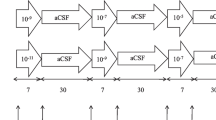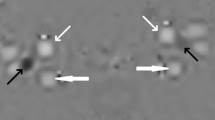Summary
The behaviour of Pial vessels to levels of CSF-pressure between 10 and 100 mmHg induced by vetricular infusion of mock CSF, was observed in 6 cats under barbiturate and N2O anaesthesia, using the cranial window technique and videoangiometry. Supratentorial pressure (STP) equaled infratentorial pressure in the cisterna magna (CMP) throughou. No changes in pial arterial calibres were noted up to a CMP of 13 mmHg (i.e. a cerebral perfusion pressure (CPP) of 100 mmHg). Further increase of CMP to 45 mmHg induced significant arterial dilatation of 40 ± 3.4%. With a further rise of ventricular fluid pressure (VFP) no marked further arterial dilatation occurred. Dilatation of arteries up to 100 um resting diameter and arteries between 100 and 250 um resting diameter and arteries between 100 and 250 um was not significantly different. When CPP approached 40 mmHg, arteries were still 47 ± 3.6% dilated. Pial venous calibre did not vary by more than 20% during elevation of VFP. At CPP 47 mmHg, small and large veins were dilated by 14%. Single venous segments were compressed by crossing pial arteries and caused upstream venous congestion and distension.
Similar content being viewed by others
References
Auer LM (1978) The pathogenesis of hypertensive encephalopathy. Acta Neurochir (Wien) 27: 1–11
Auer LM, Haydn F (1979) Multichannel videoangiometry for continuous measurement of pial microvessels. Acta Neurol Scand 60 [Suppl] 72: 208–209
Auer LM, Ishiyama N, Pucher R (1987) Cerebrovascular response to intracranial hypertension. Acta Neurochir (Wien) 84: 124–128
Auer LM, Ishiyama N, Hodde KC, Kleinert R, Pucher R (1987) Effect of intracranial pressure on bridging veins in rats. J Neurosurg 67: 263–268
Auer LM, Pucher R, Leber K, Ishiyama N (1987) Autoregulatory response of pial vessels in the cat. Neurol Res 9: 245–248
Auer LM, Kato Y, Mokry M, Pucher R (1988) Cerebrovascular response to changes of cerebral venous pressure and cerebrospinal fluid pressure. J Neurosurg (submitted)
Benabid AL, Persat JC, de Rougemont Jet al (1978) Intracranial pressure IV—relationship with post capillary vascular pressures. J Physiol 74: 369–378
Duvernoy HM (1983) Cortical veins of the human brain. In: Auer LM, Loew F (eds) An experimental and clinical update. Springer, Wien New York, pp 3–38
Fog M (1933) Influence of intracranial hypertension upon the cerebral circulation. Acta Psych Neurol Scand 8: 191–198
Hedges TF, Weinstein JD (1964) Cerebrovascular responses to increased intracranial pressure. Neurosurg 21: 292–297
Langfitt TW, Weinstein JD, Kassell NFet al (1966) Compression of cerebral vessels by intracranial hypertension. Dural sinus pressures. Acta Neurochir (Wien) 15: 212–222
Morii S, Ngai AC, Winn HR (1986) Reactivity of rat pial arterioles and venules to adenosine and carbon dioxide: with detailed description of the closed cranial window technique in rats. J Cereb Blood Flow Metab 6: 34–41
Shulman K, Verdier GR (1967) Cerebral vascular resistance changes in response to cerebrospinal fluid pressure. Am J Physiol 213: 1084–1088
Toda N, Hatano Y, Hayashi S (1978) Modification by stretches of the mechanical response of isolated cerebral and extracerebral arteries to vasoactive agents. Pflügers Arch 374: 73–77
Vinall PE, Simeone FA (1982) In vitro myogenic autoregulation in cerebral blood vessels. In: Heistad DD, Marcus ML (eds) Cerebral blood flow: Effects of nerves and neurotransmitters. Elsevier North Holland, Inc., New York, pp 57–64
Wagner EM, Traystman RJ (1983) Effects of cerebral venous and cerebrospinal fluid pressure on cerebral blood flow. In: Auer LM, Loew F (eds) The cerebral veins. An experimental and clinical update. Springer Wien New York, pp 223–230
Winn HR, Rubio R, Berne RM (1981) The role of adenosine in the regulation of cerebral blood flow. J Cereb Blood Flow Metab 1: 239–244
Wright DR (1938) Experimental observations on increased intracranial pressure. Aust N Z J Surg 7: 215–235
Yada K, Nakagawa Y, Tsuru M (1973) Circulatory disturbance of the venous system during experimental intracranial hypertension. J Neurosurg 39: 723–729
Author information
Authors and Affiliations
Rights and permissions
About this article
Cite this article
Kato, Y., Auer, L.M. Cerebrovascular response to elevation of ventricular pressure. Acta neurochir 98, 184–188 (1989). https://doi.org/10.1007/BF01407346
Issue Date:
DOI: https://doi.org/10.1007/BF01407346




